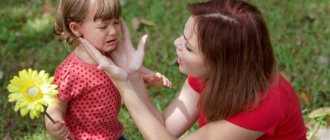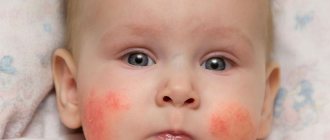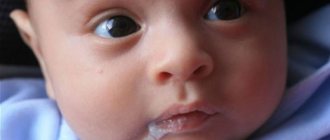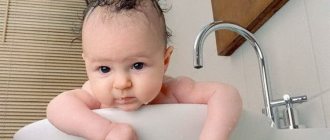How to recognize atopic dermatitis?
There is an opinion that the disease is transmitted by bottle-fed children, but this is a myth, since the percentage of dermatitis in breastfed babies is rapidly growing. Timely diagnosis will allow you to easily get rid of the first manifestations of the disease.
The main signs may be:
- Redness, itching, peeling: neck, cheeks, back, elbows and knees, buttocks
- Dry skin
- Getting wet
- Peeling of the scalp and face
- Nodular rash
- Local change in cover color
- Thin, sensitive skin, prone to cracks and damage.
A newborn will not be able to tell his parents about inconvenience or pain, so you need to pay attention to the baby’s behavior. In particular, on his mood, sleep and appetite. But many attribute the presence of these symptoms to diathesis.
Features of nutrition for neurodermatitis
Considering the predominantly food etiology of atopic dermatitis, special attention should be paid to the diet of infants.
When breastfeeding
If neurodermatitis has developed in a breastfed child, then it is important to correctly adjust the nursing woman’s diet so as to exclude potentially dangerous foods, without depleting the mother’s diet of essential nutritional components.
Unconditional allergens are chocolate, honey, fish, nuts, citrus fruits, strawberries, and spices. These foods should be excluded from the mother's diet for the entire period of breastfeeding.
A woman should receive exclusively boiled or steamed food. Fried, smoked, salty foods should not be present in her diet. It is important to follow the principle of consistently expanding the diet. For example, if a woman is absolutely sure that her child did not have allergies when she ate boiled potatoes and boiled chicken meat, she can safely eat these products.
Then the diet should be gradually expanded. A woman needs to introduce food into her diet gradually, starting with a small amount (volume). First, the diet should include fruits and vegetables of a calm color (green apple, pear, zucchini, cauliflower, etc.) and only then the diet can be replenished with foods that have a more saturated color.
It is important that a woman receives meat, a sufficient amount of grains, and fiber. Only in this way will breast milk contain sufficient amounts of proteins, fats, carbohydrates and have a good vitamin and mineral composition. Those products, the introduction of which caused the appearance of new foci of atopic dermatitis, should be completely excluded from the diet of a nursing mother.
With artificial feeding
Particular attention is paid to the choice of formula for atopic dermatitis. It can be extremely difficult to select a suitable breast milk substitute in each specific case, since all formulas are multicomponent, and a child can develop an allergic reaction to any substance included in their composition.
There are 3 types of mixtures recommended for atopic dermatitis.
- Soy mixtures (Alsoy, Bona-soy, Enfamil-soy, etc.). They are widely used in children with food allergies to cow's milk proteins. The protein component in these mixtures is soy. This group of breast milk substitutes is enriched with a vitamin and mineral complex. The mixtures are well tolerated by infants and do not cause colic or problems with stool. They do not contain lactose, so they are often recommended for children with lactase deficiency.
- Mixtures with high or complete protein hydrolysis. Formulas with partial hydrolysis of casein are used only in children with allergic predisposition, while mixtures with high or complete hydrolysis of protein are therapeutic. They all have an unpleasant bitter taste. Such mixtures are prescribed to infants with polyvalent allergies and severe atopic dermatitis. Similar breast milk substitutes include Alfare, Pepti-Junior, Nutramigen.
- Formulas based on milk from other animals (not cows). A child, for example, can be offered both goat or camel milk itself and formulas based on them (for example, Nanny’s formula based on goat milk).
During the period of introduction of complementary foods to the child
If signs of atopy appeared in a child during the period of active introduction of complementary foods, then one of the ways to identify a significant allergen is the principle of complete abolition of the introduced complementary foods, followed by their repeated, gradual introduction.
Only after the child has been “unloaded” for several days on the mother’s breast or on a well-tolerated adapted formula, vegetable and fruit purees, cereals, juices, meat, etc. can be gradually and in small quantities reintroduced into the diet.
Dermatitis or diathesis? How to distinguish diseases
In fact, the signs that appear are similar only at the initial stage.
Diathesis is the body’s tendency to allergic reactions , and a predisposition is not a disease. For the most part, once the irritant is eliminated, it goes away quickly . But dermatitis does not, it remains for a long time, in some cases for life.
There can be many reasons for the occurrence of dermatitis:
- Genetic predisposition (if one of the parents is allergic, then the risk of the disease is 40%).
- Presence of allergens in food. Proteins (found in cow's milk, eggs, grains, fish), pork and chicken, soy products, vegetables (carrots, beets, potatoes), fruits (grapes, citrus fruits, raspberries, strawberries, bananas, peaches), chocolate, honey, nuts.
- Irritants in the air. Dust, pollen, hair, pet dander, tobacco smoke, aerosols and substances with strong odors.
- Bacteria, viruses, fungi.
- Chemicals: soap, shampoo, creams (including diaper creams), oils, powders for washing clothes.
- Fabrics: wool, silk, linen.
- Psychological trauma (conflict situation in the family).
- Smoking, drinking alcohol and taking medications during pregnancy can also cause the disease.
If it becomes clear that the child has dermatitis, then special care will be required for him.
When should you see a doctor?
You should consult a doctor at the first manifestations of the disease to prescribe treatment and prevent possible complications. And complications can appear both immediately after the uncontrolled manifestation of the first symptoms, and after several years. For example, allergic rhinitis can provoke inflammation of the adenoids, exacerbation of otitis media, and diseases of the larynx. In severe cases, bronchial asthma may develop.
First of all, the doctor collects a family history: what allergies the parents have, the psychological state of the family, the child’s daily routine and diet, what the baby eats, what clothes he wears. If necessary, you should get tested for allergens.
At the first manifestations of allergic reactions, a pediatric dermatologist will help parents identify and eliminate foods that cause negative consequences from the diet. At the same time, the diet should be balanced so that the baby, even if certain foods are excluded, has enough nutrients, minerals and vitamins necessary for the proper development of the body.
Sweets must be excluded, as carbohydrate foods increase the intestines’ ability to absorb food allergens.
Proper care for a baby with atopic dermatitis
Increased hydration of the affected areas of the skin is necessary; it is better to choose creams and lotions with nutrients. But do not forget that the chosen products must be hypoallergenic. The market offers lines for allergy sufferers, which include not only skin care products, but also washing powders, shampoos, and bath gels. All of them are aimed at moisturizing and preventing the skin from drying out.
The child should be bathed in filtered clean water (without a washcloth); if the pediatrician allows, you can add herbal infusions. But bathing shouldn't be a daily ritual.
Walking in the fresh air, a normal microclimate in the family, and good, sufficient night and daytime sleep are recommended.
Causes of dermatitis
As a rule, the risk of various types of redness increases if:
- The baby's parents suffer from skin diseases.
- Complications during pregnancy, difficult delivery.
- Viral infections suffered by both the baby and the mother during pregnancy.
- Antibiotics and other medications taken both at an early age and during pregnancy by a woman lead to a tendency for allergic reactions to occur.
- The baby suffers from dysbiosis or various intestinal diseases.
- Failure to comply with basic rules for caring for a newborn.
- Early introduction of complementary foods and non-compliance by the nursing mother with a reasonable diet.
Accordingly, when using the same care products, with an identical diet, different children may experience different reactions. Among the most common causes of dermatitis:
- baby washing products – shampoo, soap, washing powder;
- an incorrectly selected diaper or features of its surface in contact with the baby’s skin;
- increased room temperature (baby overheating) and high humidity;
- Food.
Treatment of atopic dermatitis in infants
It is possible to cure atopic dermatitis with an integrated approach . There are several methods of therapy:
Non-drug
First of all, it is necessary to eliminate all allergens in the diet. A nursing mother should change her diet. For formula-fed children, it is better to switch to dairy-free formulas and eliminate cow's milk. It is also necessary to review baby care products for washing clothes; all of this should be hypoallergenic. Again, there will be a need to control the temperature and humidity in the house. The optimal temperature is not lower than 22 degrees with a humidity of 50-70%.
Medication
If the above measures do not help, drug therapy is prescribed, which in turn comes in two types: local and systemic approach.
Local consists of applying creams and ointments to the affected areas of the skin (only as prescribed by a doctor):
- Anti-inflammatory ointments contain substances that prevent the inflammatory process.
- Antimicrobial creams contain antibiotics and antiseptics that destroy bacteria on the surface of the skin.
- Wet compresses using antibiotics and antiseptics.
Systemic therapy consists of taking medications:
- Antibiotics are aimed at destroying and removing pathogenic bacteria from the body.
- Antihistamines help reduce the allergic reaction.
- Glucocorticoids (hormonal drugs) can quickly reduce the external manifestations of the disease, but are not intended for long-term use. The recommended course is no more than two weeks.
- Sedatives calm the nervous system and have a mild hypnotic effect.
ethnoscience
Treatment with folk remedies can also become a real lifesaver. But before using even the most harmless herbal preparations, you must consult your doctor!
According to doctors, recipes for preparing baths, ointments, and infusions from natural remedies are best used as an additional aid to treatment, as well as in moments of exacerbation of symptoms. But it is unacceptable to use it as the only type of therapy, without consulting a doctor.
Drug treatment
To eliminate dry skin, moisturizing creams, ointments (for example, Bepanten based on dexapanthenol), creams with papaverine, as well as specialized products that contain zinc (for example, Desitin cream) can be used.
If it is necessary to relieve itching, swelling, and hyperemia, it is recommended to use the hyposensitizing gel Fenistil, approved from 1 month of life. In case of pronounced local changes, the use of the non-hormonal, but effective drug Elidel (pimecrolimus) is indicated, and only if it is ineffective, hormone-containing medications can be used (for example, Advantan, approved from 6 months of age, Elokom, recommended from 2 years).
During the first 7–10 days, the use of systemic hyposensitizing drugs (Zyrtec, Suprastin, Fenistil, Zodak, Tavegil) is indicated. In this case, 1st generation drugs are preferable, because in addition to their main effect, they have a depressant effect on the central nervous system (relieve itching, eliminate the child’s neuropsychic agitation). In addition, 2nd generation drugs are officially approved in pediatric practice only from 2 years of age.
When bacterial microflora is attached to foci of neurodermatitis, the prescription of local antibacterial ointments and powders (for example, Levomekol ointment, erythromycin ointment) is justified. In case of severe atopic dermatitis in an infant, its diffuse form, complications with pyoderma, profuse oozing, the child must be hospitalized in a hospital, followed by systemic antibacterial therapy and the possible use of systemic corticosteroids.
Atopic dermatitis is a disease that primarily requires patience from parents, especially from the mother of the baby. It is on her shoulders that the responsibility falls on identifying a product that is allergenic for the child, eliminating factors that aggravate the disease, and maintaining a hypoallergenic lifestyle. A woman faces a difficult task in correcting her diet in cases of the development of atopic dermatitis during breastfeeding. However, it is not at all necessary that blood pressure will bother the child for the rest of his life or develop into some serious illness. Most children eventually “outgrow” their allergies and, at a more conscious age, enjoy the pleasant taste of chocolates, juicy tangerines and other previously forbidden foods.
Author: Bazazhi Daria Alexandrovna, pediatrician
Educational program on the topic
We recommend reading: Enterovirus infection in children: prevention, symptoms and treatment
Author
Daria Bazazhi
Pediatrician
She received a higher medical education and works as a pediatrician. Married, has two children.
Share
Reliable and effective recipes for atopy for infants:
- Herbal baths.
- Pour boiling water over four tablespoons of chamomile (per liter) and let steep for 2-3 hours.
- One tablespoon of string per glass of water brought to a boil, leave for 15 minutes.
- For a glass of hot water, one spoon of starch (potato or rice), stir well before use.
- Dissolve five tablespoons of salt (sea salt) in the prepared bathtub.
- Infuse a handful of nettles . Attention! The permissible bath time is no more than 10 minutes.
- Boil 5 tablespoons of sage for about 30 minutes. Let it brew for 2 hours (store the finished infusion in a cool place).
- Compresses
- Mix equal parts freshly squeezed celery juice with apple cider vinegar, add a pinch of salt (table salt). Apply lotions to the affected areas for 5 minutes every two hours. If the condition worsens, apply in a course of one week.
- Brew 3-4 bay leaves. Apply the resulting solution to the child’s skin for two weeks.
- Infuse a small amount of calendula flowers and apply to problem areas.
- Compress to relieve itching. Apply a lotion with potato juice to the affected areas and leave overnight. The procedure is carried out once a day until the condition improves.
- Make a mixture of herbs in equal proportions (celandine, St. John's wort, yarrow), brew with boiling water, let it brew. Make lotions from the strained and cooled broth onto the affected areas.
- Mix hops and a teaspoon each, cook in 150 ml of water over low heat for 10 minutes. Leave for 2 hours out of reach of light.
- For drinking.
- Take 5 ml of fresh celery juice 15 minutes before meals. The course of administration is 2 times a day for a week.
- Prepare an infusion of hops in a ratio of 1 to 4. Drink 50 ml before meals. Attention! It may cause side effects (vomiting and nausea).
- 5 tablespoons of viburnum per liter of water (leave for 24 hours). Drink one glass a day, not in large sips, for two weeks. Contraindicated for children under six months of age.
- Ointments
- Combine 10 ml of St. John's wort juice with 20 grams of melted butter. Apply the resulting ointment to the affected areas at least 2 times a day. Store the finished product in a cool place.
- Mix calendula juice with lanolin in a ratio of 1 to 10.
- Combine baby powder with 30 grams of white clay. Apply for 20 minutes 3-4 times a day. After use, moisturize the skin with nourishing cream.
- Mix two tablespoons of sea buckthorn oil with a quarter cup of animal fat. Store in a cool place.
- Rubbing the skin with aloe vera juice.
Feedback from parents about traditional medicine is not clear. Most people agree that these recipes will only help alleviate the baby’s condition, but they cannot do without medications.
Prevention
To reduce the risk of atopic dermatitis in infants, there are several recommendations for young parents:
- It is necessary to introduce new products into the child’s diet only one at a time with an interval of one week in order to accurately determine which product the baby may have an allergic reaction to;
- When feeding a baby with breast milk, the mother should not neglect the diet; the baby may also be allergic to the food that the mother eats. Thus, “allergic” foods should be excluded from the diet - salty, sweet, smoked, spicy;
- You can get rid of diaper hives by changing the brand of diaper. You also need to pay attention to the quality of the fabrics from which diapers and clothes are made; it is recommended to use only natural materials;
- You should wash things only with hypoallergenic washing powders using a re-rinse mode.
To prevent skin allergic inflammation, it is recommended to bathe the baby in herbal baths: nettle, yarrow, burdock root, birch buds. But bathing a baby in a bath with infusions of string, oak bark, plantain leaves and calamus root is strictly prohibited, since these compositions contribute to even more drying of the skin. You should mix these components in equal proportions and brew 1 tablespoon of the composition in 1 liter of water. And then the broth is added to the bath. After bathing, it is enough to wrap the baby in a terry towel to absorb the water, and immediately apply moisturizing and softening lotions or creams to the skin. Manganese baths (pale pink solution) disinfect the child’s skin well.
Also, do not neglect physical therapy, which not only helps speed up the healing process, but also helps the child cope with an unpleasant illness and normalize his state of mind.
It should be remembered that atopic dermatitis can not only be a reaction to any allergen, but also develop against the background of dysfunctional relationships in the family, because although the baby is small and still does not understand many things, the child’s psyche reacts sharply to raised voices, changes in emotional background in the family. Science has established that many diseases, including childhood skin diseases, can be caused precisely by a constant stressful situation and emotional tension.
Alternative medicine for atopic dermatitis
also another way to recovery from atopic dermatitis, related to alternative medicine.
Many psychologists claim that all diseases arise from negative thoughts. This opinion is shared by the American psychologist who developed her own program for getting rid of various diseases, Louise Hay. In his book “Heal Yourself” he says that all skin diseases are caused by negative thoughts and emotions : fear and anxiety.
The author suggests using harmonious affirmations as healing, convincing yourself of confidence and self-love. There is a whole treatment program developed by Louise. In her opinion, after completing the full course, which takes one year, complete recovery occurs. Opinions about the effectiveness of her program cause a lot of controversy, especially among doctors who look at this method rather skeptically.
However, it is difficult to argue that constant stress can not only aggravate the course of any disease, but also provoke exacerbations of chronic diseases, which include atopic dermatitis. Therefore, no matter how you feel about alternative medicine and treatment using affirmations, spells and other “magical” manipulations, you should not only use medications in the treatment of atopic dermatitis, but also provide a calm, friendly atmosphere.
Diagnostics
Prescribing effective treatment requires timely diagnosis of the disease, clarifying its form and identifying the etiological factor. To quickly make a correct diagnosis, you should consult a dermatologist or allergist.
It is usually enough for a doctor to conduct a survey of parents to collect a complete history of the disease and the child’s life, detailing the existing risk factors for the development of allergic dermatitis. To confirm the diagnosis and differentiate it from other pathologies, additional research methods may be required:
- general, biochemical blood test,
- stool examination for dysbacteriosis, scatological examination,
- Ultrasound of the abdominal organs, kidneys, pelvis,
- conducting allergy tests,
- study of immune status.











